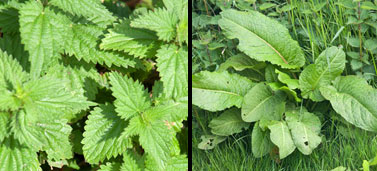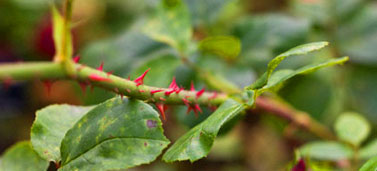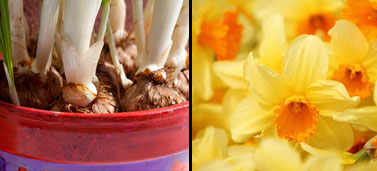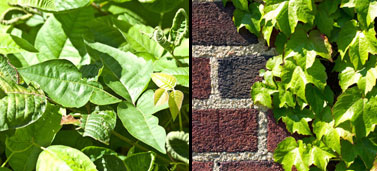Stinging nettles

Nettle leaves (pictured left) are covered in tiny, needle-like hairs. When you brush against a nettle, the hairs break off, penetrate your skin and sting you, producing the familiar burning sensation, itch and rash.
The dock leaf (pictured right) is an effective natural remedy for nettle rash. The dock leaf contains chemicals that when rubbed over the sting, neutralise it and cool the skin down.
What to do: If you get stung by a nettle, look out for a dock leaf to rub on the rash. Dock leaves usually grow close to nettles. It's also a good idea to teach toddlers what stinging nettles look like so they can avoid them.
Giant hogweed

Giant hogweed can grow up to five metres tall, often along footpaths and riverbanks. If the sap of the plant comes into contact with your skin, it can cause severe, painful burns and make your skin sensitive to strong sunlight.
What to do: If you touch a giant hogweed, cover the affected area and wash it with soap and water. The blisters heal very slowly and can develop into phytophotodermatitis, a type of skin rash which flares up in sunlight. If you feel unwell after contact with giant hogweed, speak to your doctor.
Thorny plants

Thorns, needles or spines from plants such as roses, holly, blackberry bushes and brambles can cause infections or other problems if they become implanted in your skin.
What to do: Remove thorns with tweezers – sometimes this is easier after soaking the area in warm water for a few minutes. Avoid injuries by teaching children how to check for plants with spiny leaves or thorns and always wear gardening gloves when handling thorny plants.
Poisonous plants

Most British plants are harmless, but some are poisonous, such as:
- the yew
- daffodil bulbs
- chrysanthemums
- hemlock water dropwort
- deadly nightshade
- snowdrops
- mistletoe
Their leaves, berries, flowers, fruit, sap or bulbs can poison you, either by making you ill after eating them or giving you a skin rash after touching them.
What to do: Remind children not to eat anything from the garden, unless you've said it's OK. If anyone shows symptoms such as tummy ache, vomiting, rashes or diarrhoea after playing outside, take them to an A&E department immediately with a sample of what they've eaten. When picking and eating wild mushrooms and berries, such as blackberries and elderberries, be absolutely sure of their identity beforehand.
Poison ivy

Poison ivy (pictured left), which causes a painful and itchy, blistery rash on your skin when touched, only grows in North America.
English ivy (pictured right) – which is the type that you see climbing walls and in hanging baskets and window boxes – isn't harmful. You should still be careful when handling it if you have sensitive skin as its sap can be irritating.
Parsnip plant

The parsnip plant (Pastinaca sativa) grows in the wild and is cultivated in gardens and allotments.
Contact with the plant can make your skin very sensitive to light leading in some cases to burning, blisters and a painful rash.
The problem seems to be the plant's sap which contains chemicals called furoumarins. These chemicals are absorbed by the skin and can then react with sunlight to cause skin inflammation.
What to do: Watch out for wild parsnip in roadside ditches and along railway tracks. If you develop skin irritation or blisters after touching parsnip plants, speak to your doctor.
The Royal Horticultural Society has advice on how to keep your family safe from potentially harmful garden plants. You can also call its helpline on 0845 260 8000, from 10am to 12.30pm and 1.30pm to 4pm.
Read about 10 insects that can bite or sting you.
